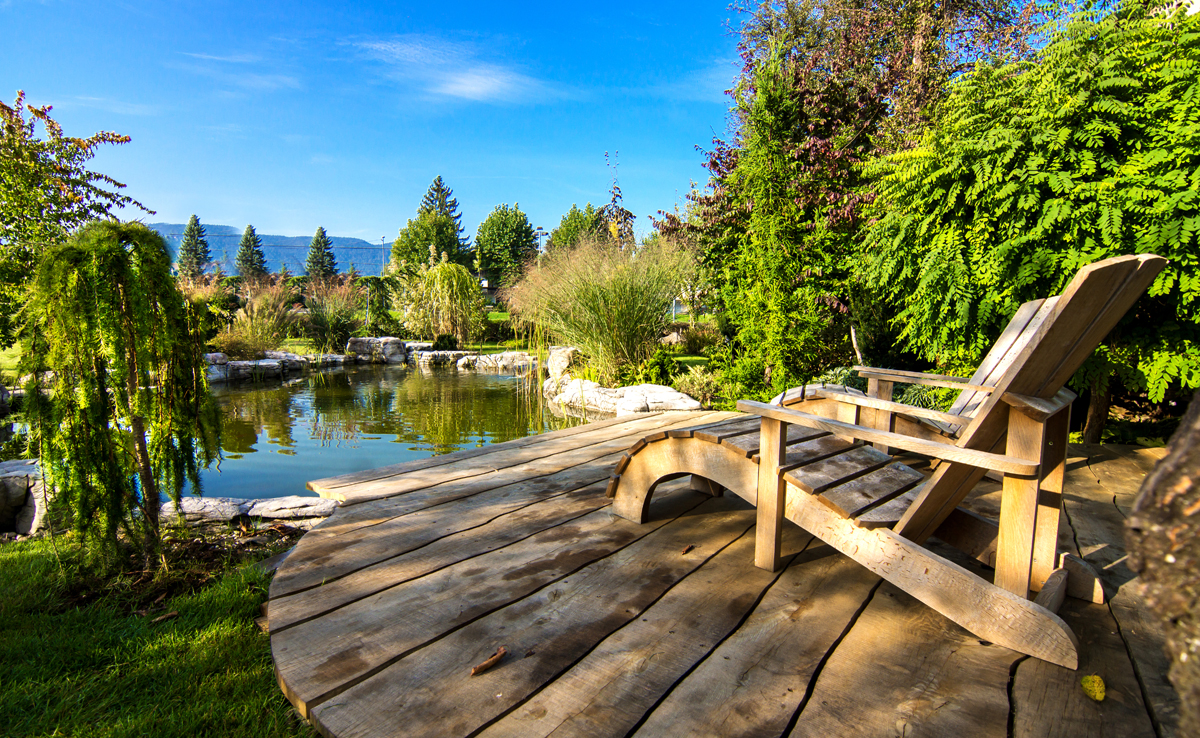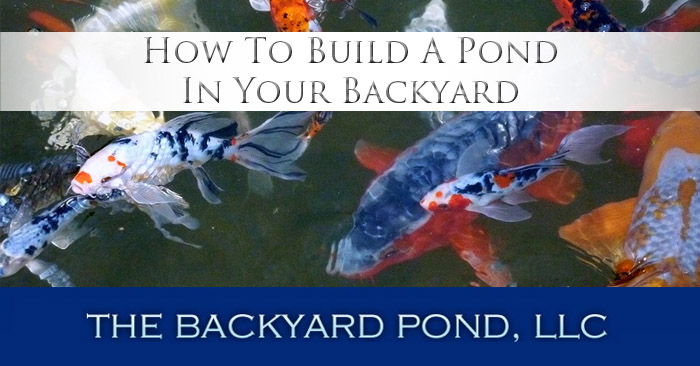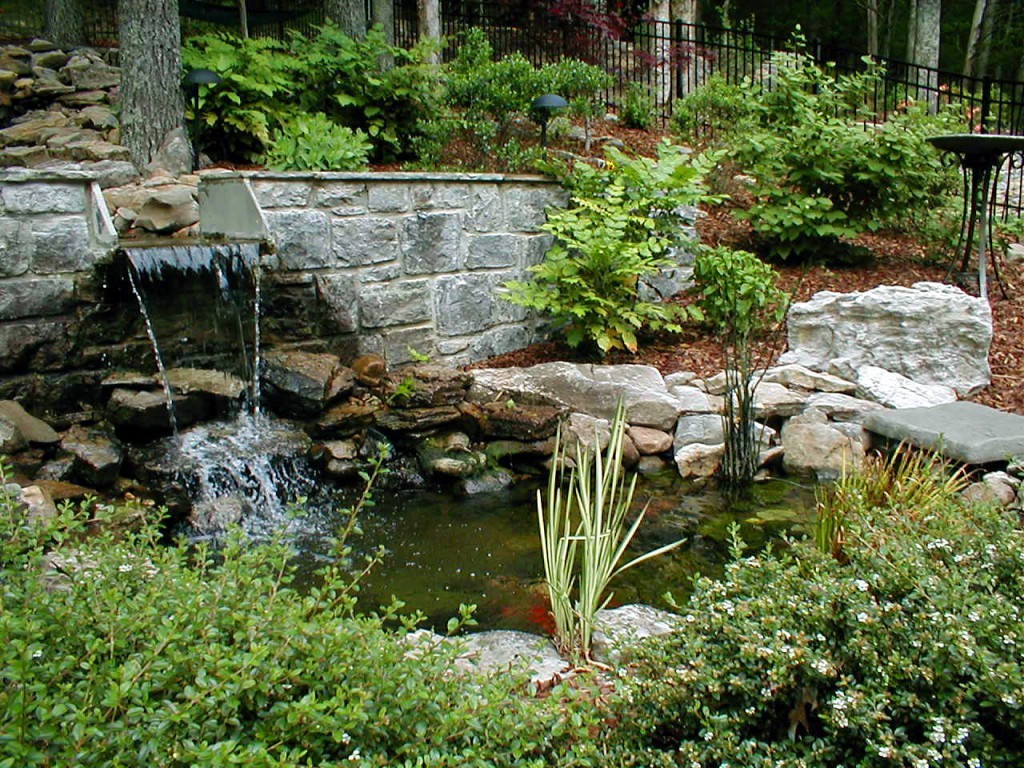Picking a location for your pond
- Install your pond on well-drained, level ground.
- Plan a direct line between the pond and your home for electrical wiring.
- Ensure that the pond site isn’t over pipe, sewer lines, septic fields, or cables.
- The more sunlight your pond has, the more choices for your water plants. If you add fish, balance the sun with shade during the hottest parts of the day by adding lotus pads, shrubs, plants, water lilies, or portable shade screen.
- Small ponds will benefit by having partial shade because high water temperatures can cause excessive algae and water evaporation.
- Avoid placing your pond near trees or in areas of high winds. Falling needles and leaves will contaminate the pond which can clog the pump and filtration system.
- Pick at least 2 alternative sites in case the location your picked won’t work.
Caution – Before you begin digging, call 811 to check for any underground utilities.
Option 1: Using a flexible liner
Putting in a liner only takes 4 steps. Digging a hole, putting the liner down, filling the pond, and adding edging or stones around the pond.
Step 1:
Use flat shovels to remove strips or patches of sod in the pond area. Remove the grass about 6-12 inches away from the pond so you will have a flat surface.
Step 2:
Beginning at the edge, dig a trench for your edging of about 1 foot deep. Then remove the dirt in layers within the pond area by starting in the center. Dig 2 inches deeper than actual depth to allow for sand underlayment. Create an area for overwinter plants and fish. In colder areas, you will need to find an area that doesn’t freeze. It needs to be 3 feet wide and 3 feet deep. Do not add a pump or fountain in this area. Dig about a 12-inch shelf for plants that like shallow water. Position the shelf so that the plants will frame the water garden. Dig a ledge that is as deep as the edging minus 1 inch and less wide. Top off the edging with at least 1 inch above the terrain to prevent runoff from entering your pump. When you dig, ensure that you are angling the sides slightly, and ensure that the edges of the pond are level with the sides. If it isn’t level, then the liner will show. You can check this by placing a leveler on a board across the hole.
Step 3:
Inspect the hole for any sharp roots or stones carefully and remove them. Flexible liners are prone to punctures from gravel, rocks, broken roots and sharp objects. Cushion your liner with sand underlayment. Use about 2-3 inches of sand or newspaper. Many water garden suppliers will offer a tough underlayment material made just for pond liners. Put your material in the bottom of the hole and on the shelves on the pond. Pack damp sand into holes on the sides where rocks and roots were removed.
Step 4:
Pick a sunny, warm day to install the liner. You can make the liner flexible by laying it on warm pavement for half an hour. Don’t drag the liner to keep it from being punctured.Have help to drape the liner into the hole with an even overlap on the sides. Weigh down the edges with some smooth bricks or flat stones. Once you have the liner in place, start filling the pond. When it fills, adjust the liner to make it fit the sides of the pond, and smooth out creases and wrinkles. While it is filling, slowly ease the stones off the liner to prevent overstretching. When it is full, trim the excess off. Leave enough liner around your pond to extend under and a few inches behind the edging stones.
Step 5:
To keep your liner in place when adding your edging, use 20d nails through your line and into the ground every foot around the rim. If you are using natural stone, then experiment with different arrangements until you find the one that looks most natural. Although, flat stones can be placed directly over the liner, you need to position them so they won’t fall into the pond. To keep stones from moving simply mortar them in place. Mortar is premixed and is cheap.
Option 2: Using a Shell Liner
The ground for these liners need to be free of sharp objects, stable and firm. Keep in mind that the shell when filled can be more than 100 pounds. Any empty spaces or bumps can cause the shell to buckle or crack. In sandy or lose soil, ground water may cause erosion which create empty spaces and weaken the liner. Freezing and thawing during winter seasons can cause the shell to buckle. Backfilling helps to prevent these types of issues.
Step 1:
Flip the shell upside down in your pond area and mark the outline on the ground. You can also have it upright and use stakes to outline the shape of the shell. Outline the shell with a garden hose, flour or paint. Use stakes about 12 inches apart to keep the rope or hose in place.
Step 2:
Dig your hole to fit the shell, and allow an extra 2 inches around the pond and about 3 inches in the bottom of the hole. If the shell has any shelves, then ensure to cut ledges at the right areas to support the shell. The shell needs to be supported everywhere. Remove any sharp objects and rocks then add 3 inches of damp sand to the bottom of the hole. Smooth the sand using a board and pack the soil firmly to provide a strong base for the shell. Ensure that the bottom of the hole is level in all directions by using a level on a board on the sand.
Step 3:
Using help, set your shell into the hole and check the height of your rim. It needs to be 1 inch above the ground to prevent runoff from going into the pond. Remove or add soil. From the bottom of the hole to get the right height. Place wood on the rim and check with a level in different areas, and pull the shell out to relevel as needed.
Step 4:
Ensure that the pond is level before you begin to fill it. When the water rises, begin to backfill using damp sand and pack it gently with the end of your shovel. Ensure that you are filling the empty spaces, especially around the shelves. Ensure it stays level as you fill. Don’t allow the water to go above the backfilled area outside of the rim or it will bulge outwards. Try to make the pressure equal while you backfill it.
Step 5:
When the shell is full, you can conceal the rim with rocks, or overhanging plants. If you are using flagstone, allow them to overhang the edges by about 2 inches. The weight of the edging could damage or deform the walls, so don’t add the full weight on the rim.
Maintaining your Pond
There are a lot of treatment products to keep the pond clean for your animals and plants including:
- Pond tint
- Lime scale remover
- Sludge remover
- Chlorine remover
- Barley pond cleaner
- Algaecide
Maintaining the pond fountain
- If you have green water, use a UV sterilizer or algaecide. If there aren’t animals in the water, treat it aggressively. UV sterilizers work to stop algae growth and prevent green water.
- If you have string algae, remove as much of it as possible before your treat it. This keeps the string algae from decomposing and clogging the pump.
- Lime scale remover will be able to remove lime scale deposits. Read the instructions that are with your fountain to make sure that there isn’t a special coating or treatment that can be harmed during treatment.
- Maintain the pump by making sure that your fountain has plenty of water. Sometimes when the pump isn’t submerged, the motor will keep spinning and this causes the motor to burn out.
- Pond tint (blue dye) may be used, but it could stain fountains. Test in an unnoticeable area before using. Pond tint is great for keeping algae away from the sunlight.
Backyard Pond Design & Installation
If you live in Arizona in the Valley of the Sun The Backyard Pond is your source for high quality ponds, pond accessories, and Koi fish. We can help with your backyard pond design including the size, layout, and look of your backyard pond and help you with installation. We also can help maintain your pond and care for the health of your Koi. If you have questions about how to get your backyard pond project started or would like to schedule an appointment please call us today 623-878-6695.


